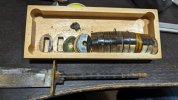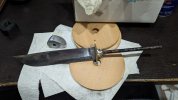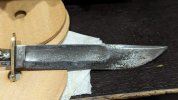- Joined
- Oct 24, 2023
- Messages
- 291
Howdy folks. I don't really know age and I can't find anything similar. Passed down from I think grandfather to dad to me. No idea if this was some kind of kit knife, production, converted or what. Looks like acrylic wasn't even production until the 1930's so its likely after that. I would guess pre-1950's when dad left. Purely guesswork though and possibly wrong. I looked around for catalog and searched forum a bit but found nothing obvious. If anyone has any details or perhaps link to the catalogs please share. Did the forums lose the old catalogs pre 2015? I am guessing the red X's mean the data was lost.
The pommel is loose, I think one of the spacers is missing and another is broken. It is really hard to align the handle bits back in place. Hand tightened is shown in a pic and past alignment. I would guess this is acrylic. I don't particularly love the acrylic but I can appreciate what someone did. If it is of significance I could get some black spacer material (likely g10) and try to fix. Or perhaps get leather and convert it to stacked leather. I was thinking leather may provide a little push back on the pommel holding it in place better? If I do go with acrylic I am not sure how to fix exactly. Since the bits are hard to align I would assume I would have to get them as good as I can and just re-profile the handle thinner. How do you align that pommel? Just get the spacer and sand to near exact thickness needed? Does the pommel require anything beyond torque/pressure?
I read somewhere to soak old leather (the sheath) in mineral oil for weeks to rejuvenate. Is that good advice?
Thoughts? It needs some love.
Cheers,
Rick
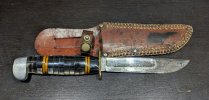
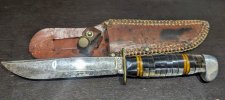
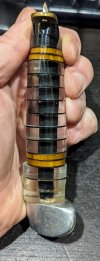
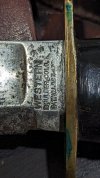
The pommel is loose, I think one of the spacers is missing and another is broken. It is really hard to align the handle bits back in place. Hand tightened is shown in a pic and past alignment. I would guess this is acrylic. I don't particularly love the acrylic but I can appreciate what someone did. If it is of significance I could get some black spacer material (likely g10) and try to fix. Or perhaps get leather and convert it to stacked leather. I was thinking leather may provide a little push back on the pommel holding it in place better? If I do go with acrylic I am not sure how to fix exactly. Since the bits are hard to align I would assume I would have to get them as good as I can and just re-profile the handle thinner. How do you align that pommel? Just get the spacer and sand to near exact thickness needed? Does the pommel require anything beyond torque/pressure?
I read somewhere to soak old leather (the sheath) in mineral oil for weeks to rejuvenate. Is that good advice?
Thoughts? It needs some love.
Cheers,
Rick






